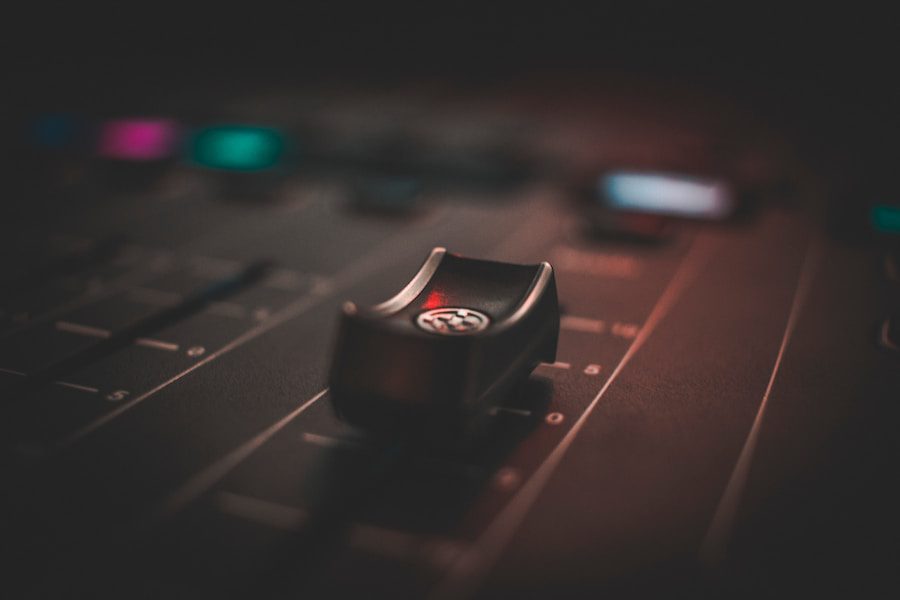A fader is a component found in audio equipment used to control an audio signal’s volume. It is typically a sliding knob or lever that can be moved up or down to adjust the signal level. Faders are commonly found on mixing consoles, DJ controllers, and other audio equipment.
A fader is a control commonly used in audio mixing consoles and software. It is a sliding knob or lever used to adjust an audio signal’s volume or level. Faders are typically found on the channels of a mixing console, and they can be used to control the level of individual instruments or voices in a mix.
Faders can also create various effects, such as fades and crossfades. Slowly moving a fader up or down can gradually introduce or remove an audio signal from a mix. This technique is commonly used in music production and DJing to create smooth transitions between songs or sections.
Table of Contents

What is a Fader?
One of the primary uses of a fader is to control the volume of individual audio channels in a mix. For example, a mixing console may have multiple faders corresponding to different song instruments or vocals. By adjusting the faders, the sound engineer can balance the levels of each channel to create a cohesive mix.
Types of Faders
Several different types of faders are commonly used in audio mixing:
- Linear Faders: These faders have a linear response, meaning that the level of the audio signal changes at a constant rate as the fader is moved.
- Logarithmic Faders: These have a logarithmic response, meaning that the audio signal level changes more slowly at the lower end of the fader’s range and more quickly at the upper end.
- Motorized Faders: These are automated and can be programmed to move to specific positions based on presets or automation data.
Functions of Faders
Faders serve several important functions in audio mixing:
- Volume Control: Faders are primarily used to adjust the volume or level of audio signals.
- Panning: Faders can also be used to adjust the stereo position of an audio signal by adjusting the balance between the left and right channels.
- Muting: Faders can mute individual channels or groups of channels.
- Soloing: Faders can solo individual channels, allowing the engineer to hear only that channel in isolation.
- Automation: Faders can be automated, allowing the engineer to program changes in volume, panning, and other parameters over time.
How Does a Fader Work?
A fader is a key component of an audio mixing console that allows the user to control the volume of an audio signal. The fader is responsible for controlling the audio signal level as it passes through the mixing console. This section will discuss the components of a fader and the signal flow through a fader.
Components of a Fader
A fader consists of several components that control the audio signal level. The main components of a fader include:
- Slider: The slider is the part of the fader that the user moves up and down to control the audio signal level.
- Fader Track: The fader track is the slider’s path. It is usually made of conductive material to transmit the audio signal.
- Wiper: The wiper is a small metal contact that moves along the fader track as the slider is moved. The wiper is responsible for picking up the audio signal from the fader track.
Signal Flow
The audio signal flows through the fader in a specific way. The audio signal is routed to the fader when it enters the mixing console. The audio signal then passes through the fader track and reaches the wiper. The wiper picks up the audio signal and sends it to the output stage of the fader. The output stage then sends the audio signal to the next stage in the mixing console.
When the user moves the slider up or down, the wiper moves along the fader track, changing the amount of audio signal picked up. This change in the audio signal level is then sent to the output stage and on to the next stage in the mixing console.
Fader Applications
A fader is a common tool used in audio production to adjust the level of a sound signal. It is a simple device used to control a sound signal’s volume by sliding a lever up or down. Faders are used in various applications, including live sound, recording studios, and broadcasting.
Live Sound
In live sound, faders control the volume of individual channels in a mixing console. The mixing console is the central hub of a live sound system and is used to mix and balance the various sound sources. Faders are used to adjust the volume of each channel to create a balanced mix. Live sound engineers use faders to control the volume of individual instruments, vocals, and other sound sources to create a cohesive and balanced sound.
Recording Studios
In recording studios, faders control the levels of individual tracks in a multitrack recording. Multitrack recording records each instrument or sound source on a separate track, which can be mixed later.
Faders are used to adjust the levels of each track during the mixing process to create a final mix. Recording engineers use faders to control the volume of individual tracks and create dynamic changes in the mix by using automation.
Broadcasting
In broadcasting, faders control the levels of audio signals in a radio or television program. Faders are used to adjust the volume of music, sound effects, and dialogue to create a balanced mix.
Broadcast engineers use faders to ensure that the audio levels are consistent throughout the program and to create dynamic changes in the mix during transitions between segments.
Last Word on Audio Faders
After exploring the concept of a fader in audio, it’s clear that this tool plays a crucial role in mixing and editing. By adjusting the volume of individual tracks, a fader allows for precise control over the sound of a recording. Whether working in a professional recording studio or a home setup, understanding how to use a fader is essential for achieving high-quality audio.
While faders have been a staple in audio engineering for decades, technological advancements have led to digital faders that offer even greater precision and flexibility. With the ability to automate fader movements and store presets digital faders have become an indispensable tool for many audio professionals.
Overall, the fader is a simple yet powerful tool that has revolutionized the world of audio engineering. By allowing for precise control over individual tracks, this tool has enabled engineers to create technically and artistically impressive recordings.
- Review of the ALABS IRON MINI-WL: A Powerhouse Wireless Microphone - October 4, 2023
- What is a Saturator in Music Production: A Brief Explanation - May 11, 2023
- What Are Rotary DJ Mixers? An Overview - May 11, 2023
SoundStudiomagic.com is a participant in the Amazon Services LLC Associates Program, an affiliate advertising program designed to provide a means for sites to earn advertising fees by advertising and linking to Amazon.com. We also participate in other affiliate programs which compensate us for referring traffic.

